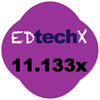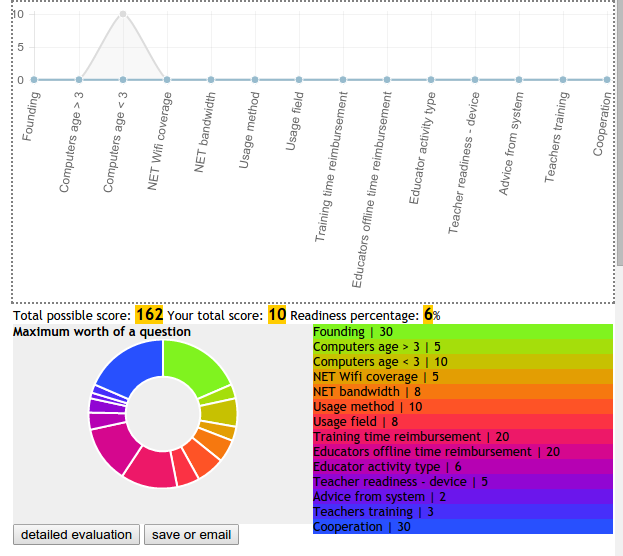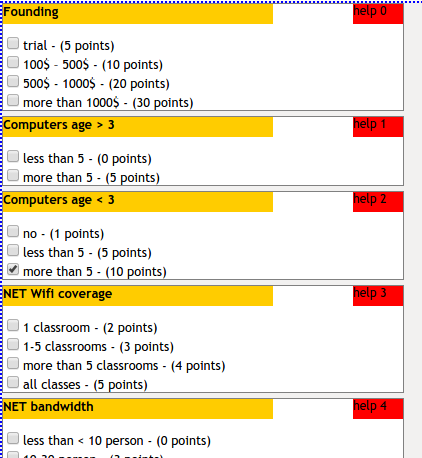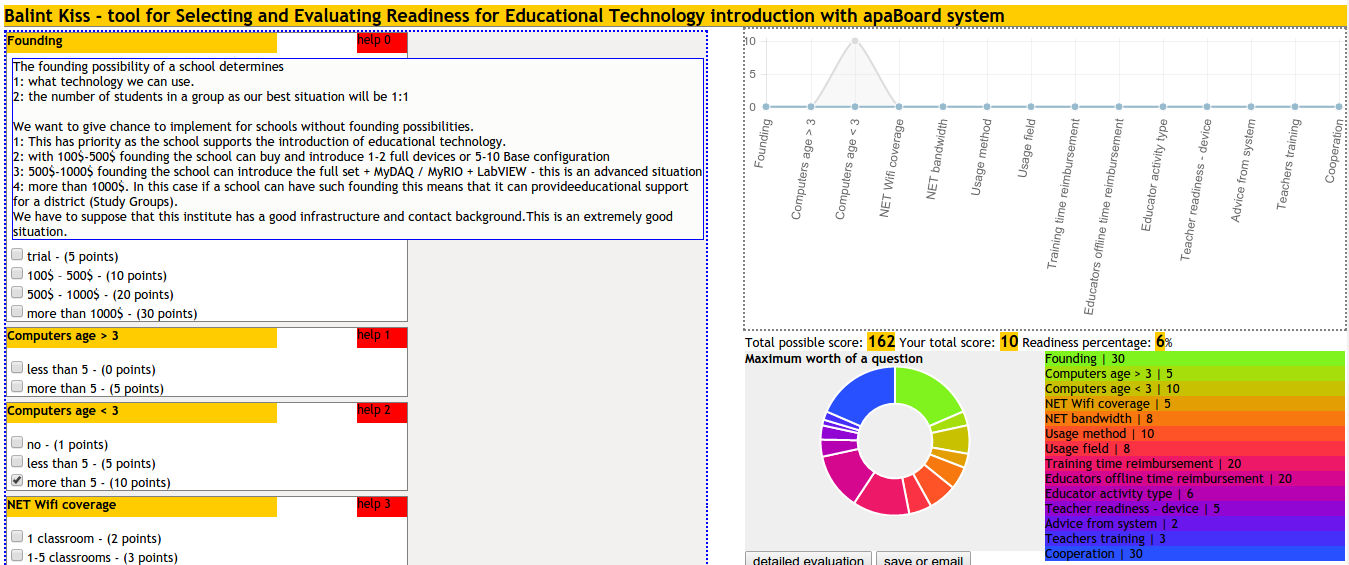MITx 11.133x - work
MITx: 11.133x Implementation and Evaluation of Educational Technology
Implementation and Evaluation of Educational Technology
| MITx: 11.133x | Eric Klopfer |
|---|---|
MITx 11.133x Course
Unit 0: Welcome
ASSIGNMENT 0.1: Pre-Course Survey
ASSIGNMENT 0.2: TALK ABOUT EDUCATIONAL TECHNOLOGY IN THE CLASSROOM
Learning technology using educational technology
| Learning technology using educational technology |
|
Hello I'm Bálint Kiss 18 years old student from Hungary. Ed tech completely changed my life. I'm interested in EECS learning, developing and instruction of electronic devices. I wanted to learn how these devices are working: like Arduinos, TI Launchpads. I've got a lot of free online resources but after some years of doing experiments I want to learn deeply the ARM microcontrollers. |
|
Here at edX I found the course named Shape the World with professor Valvano and professor Yerraballi. That was exciting and I've got my certificate. I've learned that the most important thing is: by using educational technology I know what I want to learn. By Using educational technology the learning process can be very easy and exciting. With the knowledge from edx i've designed a new tool for learning electronics by succesfull experiments. This is my tool called apaBoard. It uses a modular system. You can connect modules to modules and build devices without deep previous knowledge. Everybody can build, design and construct what he or she wants, and learn electronics by building devices. My project became quite successfull. It won a lot of prizes, I've presented my device at national and international competitions and conferences like EUCYS in Poland and Milset 2015 in Brusseles. My mentor Kertesz Krisztian who works at Institute of Technical Physics and Materials Science of the Hungarian Academy of Sciences said that if I've taught myself let's try whether this method would work for other students. So I put all my exciting experiments into this box. It is the deluxeBox. I went to schools and I've presented to more than 1000 students in classrooms and conferences. Students who have tried some of my experiments, said they would like to use my devices and methods. Now I'm interested in learning ed methods and technologies to use Massive Open Online Course for those students who are interested in learning with my electronic devices and my tools. I've learned to use a lot of software for building multimedia content, step-by-step wikis, videos, graphs, animations. I am building my own website, wiki site with multimedia content and I want to learn & use ed. tech. very efficiently. |
Unit 1: Foundations
ASIGNMENT 1.1: PROFILE YOUR TARGET ENVIRONMENT/IMPLEMENTATION CONTEXT
IoT learning IMPLEMENTATION CONTEXT
| IoT learning IMPLEMENTATION CONTEXT |
| My tool and method is for K12 (K9-to-K12) for students, educators, and communication staff of technology developers like Arduino, TI Launchpad, NI MyDAQ, MyRIO.
It can be implemented in curriculum in learning process of electronics, informatics, physics. We can get up-to-date experience for young students who are intreseted in learnig, understanding electronic technology even if they haven't pevious knowledge. |
| The technological background means that students and teachers are using a learning tool named embedded system and they have access to online materials like videos, wikis, step-by-step multimedia tutorials. The total cost is between 10$ and 300$ USD depending on the embedded system that someone has chosen. I have worked with Arduino, TI Launchpad, NI MyDAQ, MyRIO. By online tutorials students may go ahead by their own pace even without educator support. It is very suitable for blended learning. In this case students can do experiments in small or larger groups. The teachers role is facilitator in this case. Also they are involved in building and developing new methods by successful experiments. A successful experiment will be inserted into the resource. Stakeholders: Students are able to learn in a short time high technology and can access and use hightech developments. Teachers using these resources could be more efficient as they don't have to worry about developing experiments. Together with teachers, students connect the available modules what they need and they built a new device. Industrial environment is a very intresting stakeholder. Technology developers interested in usage and selling high-tech microcontrollers are also interested in education and communication of technology. Industry is also interested in dialogue with educators, mentors and teachers. Technology developers say that those young people, who can build those new devices called IoT(Internet of Things), will shape the world and they are interested in using their specific technologies or devices. I must mention the very improtant role of the researce centers (MFA) & science centers (Agora, Mobilis). Using technology can make a lesson more powerful to students. Student can have hard time to make an experiment and build everything correctly. This can be achieved by using my online resources: 1. The videos explain the problem. 2. Step-by-step multimedia contents let the students go ahead by their own pace to buil a correct device. 3. Wiki contents are summerise and contain all descriptions, documentations, source codes. 4. Feedback is in real time. If someone follows these tutorials will build a working device. It will work. Why is potential for technology to be implemented in this context? My experience is that students became very motivated to learn by building successful devices. In this case the knowledge can be used in real life. Building a toy or building a real device is exactly the same. While constructing, building, developing some successful devicees we can have access to theoretical background as a next step for deep knowledge. |
ASSIGNMENT 1.2: DOMAIN/APPROACH CHART
LabVIEW helps to understand devices
| LabVIEW helps to understand devices |
| We use microcontrollers everyday and everywhere. In the learning process we can use the so called embedded systems. There are quite cheap 10$ solutions like TI Launchpads, Arduinos and others with software and technical support like NI MyDAQ, MyRIO an ELVIS. Free resources are often can be challenging for educators as they have to spend their time to learn how to visualise data. (Energia IDE, Arduino IDE, Wiring, Processing) |
|
LabVIEW can be a good choice. Educators, students can use drag & drop interactiv elements, buttons, graphs to simulate and visualise real time electronic events or data-flows. In most of the IDEs (integrated development) could be very time consuming to develop such elements and suppose programing knowledge. If we can't visualise data, students can see only numbers. The LabVIEW is developed by engineers and uses a graphical programming language. LabVIEW's solutions witch are simple but at high-level can be succesfully used in learning process. Educators, students can learn the basics of LabVIEW in a short time and a complete explanation of a concept can be visualised in a couple of minutes. Students can quickly understand, what happens in a circuit or in a specific circumstance like using a specific sensor. Also the usage of such a software is usefull beause this technology is used in high-educational, industrial or research environment too. It is also a good argument that the developer (National Instruments) offers suupport by it's Mentorship Program (Hungary) to help and involve schools and educators. |
ASSIGNMENT 2.1: YOUR TOOL FOR SELECTING EDUCATIONAL TECHNOLOGY
My interactive online tool to analyse readiness
| My interactive online tool to analyse readiness |
| I have got a great inspiration from Stacey Allen’s Rubric to Determine Readiness for 1:1 Implementation. Thank You Stacey Allen. I’ve gathered my viewpoints and questions but my problem was that I dind’t feel the weight of a question in the evaluation process. |
Welcome to try it online from my webpage: http://eskolar.com/download/11_133/form/ You know I had talked with more then one hundred teachers, more than one thousand students, I know what they want, and what I want. In the next step I want that a school leader can use my selector tool to see whether the school is ready for implementation. You can try it online from my webpage
I’m very-very exited it shows exactly what I want. You can download it from this link. We have two charts. In this pie chart we can see the weight of a problem by its value number. The line chart shows the value of the answer given by the school leader or the teacher.
I have to finish the detailed evaluation answer option and I planned to get an email from the website with the values and to use these data in a database. |
ASSIGNMENT 2.2: CHOOSE THE RIGHT TECHNOLOGY
Choosing the right technology for apaBoard
| Choosing the right technology for apaBoard |
|
I am intrested in learning and teaching EECS (Electrical Engineering & Computer Sciences). I would like to present it's problems, and my educational technology tools. Also I will present my tools and my methods, for developeing electornic tools, and online tutorials with wikis, videos and multimedias. Why is the technology you chose the best fit for your context/target environment? |
|
If we are teachers, we want to find answers about the following questions: 1. How can we easily build successful devices? 2. What is a simple programming language for students? 3. Do we have free (open source) online resources? 4. What are their cost? Electrical learning devices are determined by two main components, hardware & software. Let see the hardware: We can buy quite cheap solutions like TI Launchpads, Arduinos. These are simple embedded sytems, the embeded system contains only 1 MCU, and that is all. But we want to build devices with sound, lights, leds, display, like robots, music toys or measuring centers... We must connect sensors and drivers to the embedded sytems, and we are in trouble because such an experiment contains many parts. It is a hard way for students, because building electronic devices can be very difficult, without previous knowlege. If we want to buy kits, we have 2 ways: 1. To buy a component kit with resistors, capacitors, leds, motors, motor driver, sensors on PCB. Also this way can be challenging for educators, as they have to spend their time building experiments. 2. Or you can choose a compact kit like boosterpacks for launchpads or shields for arduinos. We can call these moduls. In this case you can't connect all moduls to one device, because these standards have limitations. 3. apaBoard is a tool which I've developed. It is a modular multitool. On my site You can get all information about the apaboard. 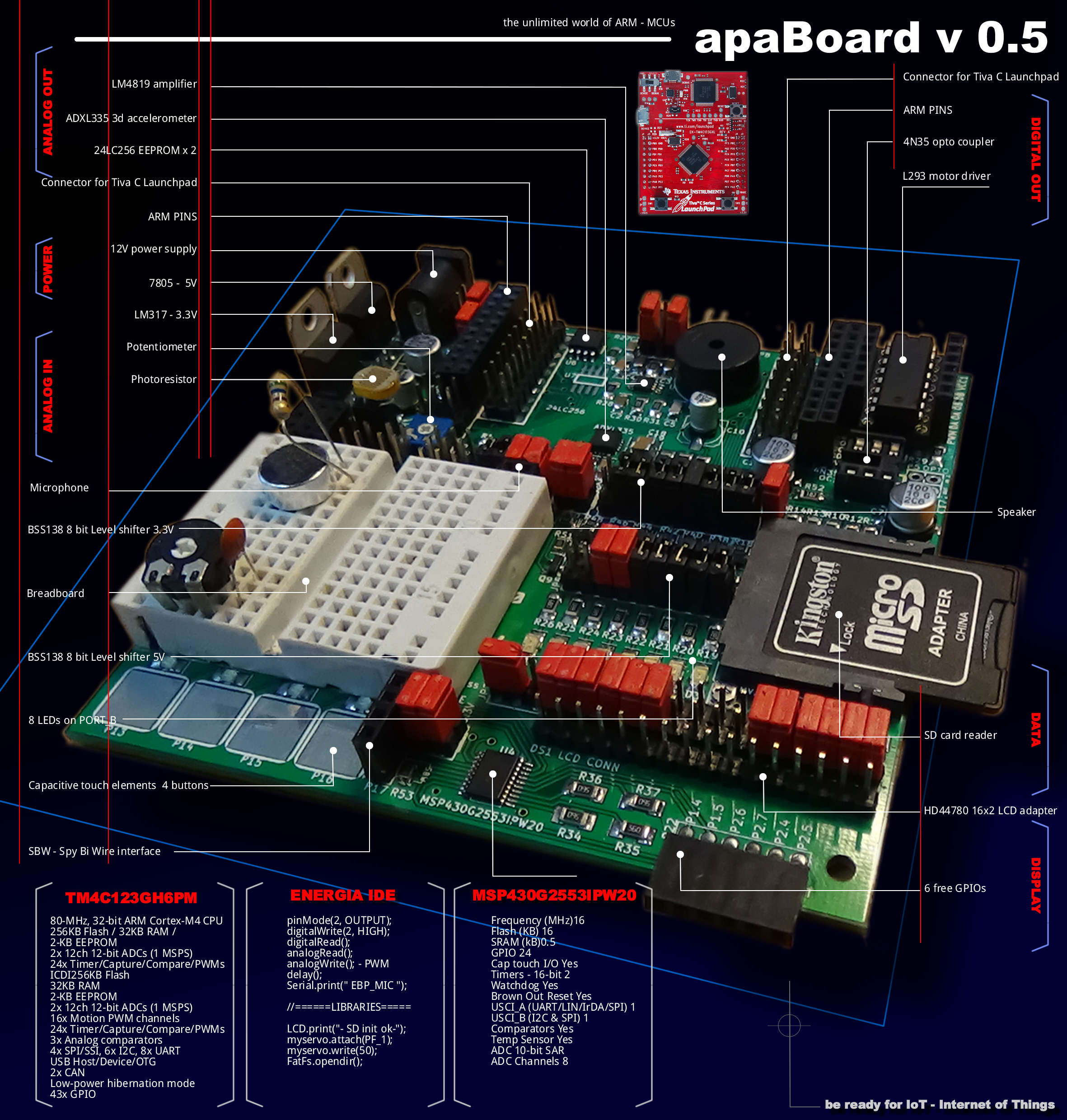 4. Another big challenge is that after the first steps, everybody would like to build, construct a physical device like robot with motors and arms. How can a teacher build a multipurpose, scalable device?. I've got the solution, this is the Deluxe box but it is heavy and a big and more complex to be reproduced. 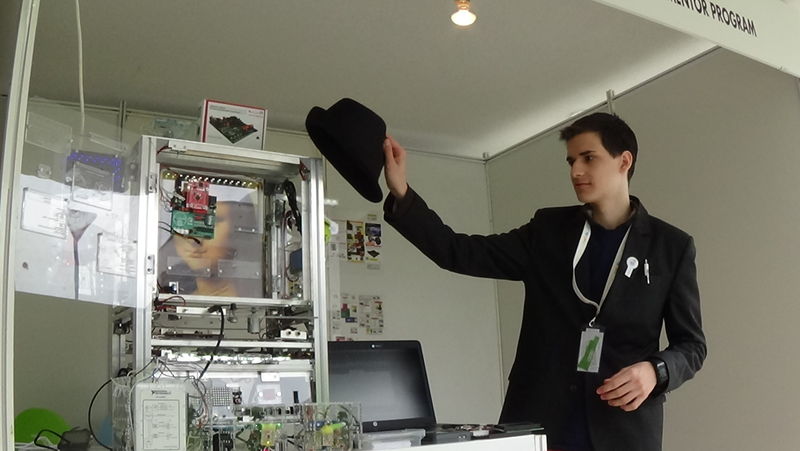 This gives me the idea to make some little deluxe boxes which I named MyBox. It can be made from a single sheet of plexiglass with laser. And it is an universal case for all type of experiments. Now we have a completely correct electrical experiment and we can build the multi purpose physical device too. 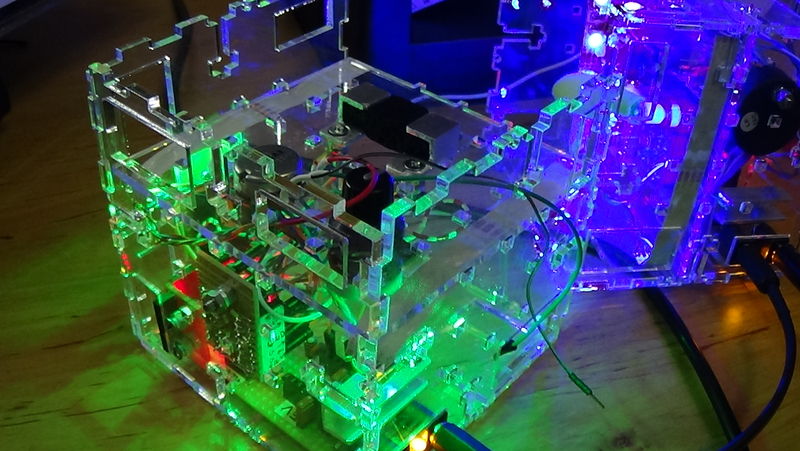 Softwares for programing MCUs: 1. The most of the IDEs use C, C++ language for programming registers. It is not a good solution for K12, is good for university's students or engineers. 2. But we have a lot of free IDEs for learning easly and working efficiently. Like Arduino IDE, and Energia IDE. These are using a simplefied C language, based on wiring, and they are good solution for K12's students. 3. Now we can do devices and we can program their MCU's, but if we can't visualise data, students can see only numbers. The LabVIEW is developed by engineers and uses a graphical programming language. Students can quickly understand, what happens in a circuit or in our tools. They can use a LabVIEW's Student Edition version, witch is free for 6 month. How do you think your implementation will improve teaching and learning (the pedagogical basis)? Teachers can adapt my learning and experimenting resources into their curriculum. For example if a teacher has a class about analog signals, or sensors, he can go to my website and he gets a completely built exciting experiment with all materials, like videos, source codes. With the apaBoard and MyBox and their online resources the preparation for a class is shorter. Each student has 1:1 device and the student can start the learning process from everywhere: for example somebody wants to build a sound recorder, or a heat sensor, or a moving car, even an eggbot. The learning process is based on building a good device and the student learns the electronics by constructing something. What is the biggest challenge you expect to encounter regarding implementation? The biggest challenge was that I have to spend a lot of time to learn a lot of softwares which I use everyday. Now I have a solid background which helps me in design, communication, resource management system. I use: Kicad, Keil/CCS, LabVIEW, MediaWiki content management system, SketchUp, LibbreOffice, FireWorks, Inkscape, LightWorks and now I'm interested in learning to use Moodle. |
A3
| If You Give a Kid an apaBoard |
|
I’ve been developing, testing, using, teaching with my tool for about two years. I’ve tested in many situations, schools, classes, ed. tech. shows, science expos: Science on Stage, Agora, Mobilis, Milset 2015 and competitions like EUCYS 2014 This is how it works in classrooms, in hand of a student. They are excited:) |
